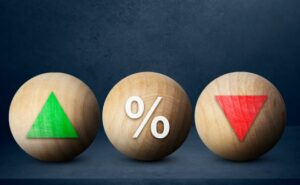Happy Summer! We hope this commentary finds you and your loved ones well as we enter the second half of the year. The first half of this year was a very painful one for investors, with most US equity benchmarks down between 20% and 35% from their respective 52-week highs. Facing a multi-decade high in inflation, aggressive monetary policy tightening by the Federal Reserve, and the effects of the Russia/Ukraine war, the S&P 500 registered its worst first half since 1970, down over 20%. The growth-heavy Nasdaq composite fared much worse, as it declined in five of the first six months this year, and posted its worst first half in 20 years, down 30%, and worst quarter since the 4th quarter of 2008. The Dow Jones index performed a little better, down 15% in the first half; however, June was its worst-performing month this year.
 All four major stock indices posted negative returns for the second straight quarter and, similar to the first quarter, the tech-heavy Nasdaq underperformed primarily due to rising interest rates. In addition, the rotation continued from high valuation, growth-sensitive tech stocks to sectors of the market that are more resilient to rising rates and slowing economic growth.
All four major stock indices posted negative returns for the second straight quarter and, similar to the first quarter, the tech-heavy Nasdaq underperformed primarily due to rising interest rates. In addition, the rotation continued from high valuation, growth-sensitive tech stocks to sectors of the market that are more resilient to rising rates and slowing economic growth.
By market capitalization, large-cap stocks marginally outperformed small-cap stocks in the second quarter. Small-cap stocks are typically more reliant on debt financing to sustain their businesses, and therefore, more sensitive to rising interest rates than large-cap stocks. Additionally, investors again moved to the relative safety of large-caps amidst rising risks of a future slowing of economic growth, or recession.
From an investment style standpoint, both value and growth registered losses for the second quarter, unlike the first quarter, where value posted a positive return. However, value did again handily outperform growth on a relative basis in the second quarter. Investors continued to move away from growth-oriented tech stocks and towards more fairly valued sectors of the market, due to rising interest rates, still-high inflation, and increasing recession concerns, although again, both styles finished the quarter with negative returns.
Beginning with the COVID-19 pandemic in March 2020, the US economy and asset markets greatly benefited from the epic jolt of trillions of dollars’ worth of liquidity doled out by the Federal Reserve and Congress. With that liquidity now drying up, the Fed began raising short-term interest rates in the first half of this year.
Over the last three Federal Open Market Committee (FOMC) meetings, the Fed has hiked rates three times in increasing increments: 25bps in March, 50bps in May and 75bps in June. June marked the first 75 basis point rate hike since 1994. While rate hikes were certainly expected this year, they came more rapidly than most thought. The war in Ukraine sent energy prices spiking, and supply-chain problems were more prolonged than expected, causing inflation to spike sharply higher and leading to more swift action by the Fed.
The story of the financial markets continues to be the balancing act being performed by the Federal Reserve. The Fed sees controlling inflation as one of its main policy goals and usually takes a very hawkish stance to get it under control. Raising interest rates will lead to the desired goal of reining in inflation. The trick is in finding the right level of rate increases – too little and inflation runs rampant for a prolonged period of time; too much stifles growth and leads to recession. It is the implications of all these decisions that have disrupted the markets for the last few quarters.
The Look Ahead
While the Fed juggles its response to inflation, the market is giving signals that point in many directions. While company valuations are certainly more attractive now than at the beginning of the year, history tells us it is hard to stay too positive in a rising rate environment. As with any tightening cycle, the risk of recession is rising. Therefore, corporate profits, which have remained strong, are in jeopardy of being revised downward.
But, even with the rising risk of recession, it’s worth noting that each one is unique. The current environment seems most similar to the early 1980s, where inflation was high in large part due to oil price spikes. In response, the Fed raised nominal and real interest rates aggressively. The economy was otherwise relatively healthy, with a solid banking system and consumers who weren’t overextended on debt, similar to now. The tight labor market we are currently experiencing also bolsters the prospects for the economy during the current cycle.
Once again, it all comes down to inflation. Inflation is even more important in this current cycle than the aforementioned corporate earnings. Inflation is a far harder problem to contain, while earnings risk can be mitigated by a change in Fed policy. Markets have aggressively priced in stubbornly high inflation and numerous additional rate hikes from the Federal Reserve between now and early 2023. If we see a definitive peak in inflationary pressures in the coming months, however, then it’s likely the Fed will hike rates less than currently feared, and that could be a materially positive catalyst for markets. There are signs that inflation may have indeed peaked. Oil prices are trending downward, providing some relief at the pump. Building materials have dropped in price and many retailers are reporting excessive inventories, signaling major discounting in the future.
Through all of this, the markets have experienced numerous economic headwinds through the first six months of the year, and they have legitimately pressured asset prices. The sentiment is still very negative at the moment, however, and a lot of potential “bad news” has been at least partially priced into stocks and bonds at these levels, again creating the opportunity for potential positive surprises. To that point, the S&P 500 has declined more than 15% through the first six months of the year five previous times since 1932. In all those instances, the S&P 500 registered a solidly positive return for the final six months of those years.
Of course, we have no crystal ball telling us what ultimately happens, but we do have a much clearer picture of the risk factors than we did six months ago. We have been appropriately adjusting portfolios to account for these risk factors, specifically increasing concentrations in high quality companies with stable earnings and valuations that are attractive on a relative basis, and trimming some more speculative, interest rate-sensitive positions. Many large-cap tech companies look to be oversold and have more resilient business models that can weather further potential economic slowdowns.
As always, an important part of the process is to ensure that your investment allocation currently meets your level of risk tolerance and your individual goals. This is a great time to review your financial plan and adjust expectations. We strongly encourage you to take advantage of all that our firm’s resources can bring to bear for you, which should help you to face the uncertain future with confidence.
As always, please feel free to reach out to our team so that we can review your specific personal situation, and ensure that your portfolio is constructed appropriately. We appreciate the opportunity to serve you and your financial needs, and appreciate the continued trust and confidence that you have placed in us as your financial partners.

Scott A. Goginsky, CFA®
Partner, Research Analyst and Portfolio Manager
Sources: Index returns – Bloomberg; Benchmark statistics, Fed rate hikes – Nasdaq; Performance review – FinSyn Insights; Recession history – Charles Schwab; Inflation – FS Insight
The information set forth regarding investments was obtained from sources that we believe reliable but we do not guarantee its accuracy or completeness. Neither the information nor opinion expressed constitutes a solicitation by us of the purchase or sale of any securities. Past performance does not guarantee future results.



Second Quarter Market Commentary
Scott A. Goginsky, CFA®
Markets Bearing The Heat
Happy Summer! We hope this commentary finds you and your loved ones well as we enter the second half of the year. The first half of this year was a very painful one for investors, with most US equity benchmarks down between 20% and 35% from their respective 52-week highs. Facing a multi-decade high in inflation, aggressive monetary policy tightening by the Federal Reserve, and the effects of the Russia/Ukraine war, the S&P 500 registered its worst first half since 1970, down over 20%. The growth-heavy Nasdaq composite fared much worse, as it declined in five of the first six months this year, and posted its worst first half in 20 years, down 30%, and worst quarter since the 4th quarter of 2008. The Dow Jones index performed a little better, down 15% in the first half; however, June was its worst-performing month this year.
By market capitalization, large-cap stocks marginally outperformed small-cap stocks in the second quarter. Small-cap stocks are typically more reliant on debt financing to sustain their businesses, and therefore, more sensitive to rising interest rates than large-cap stocks. Additionally, investors again moved to the relative safety of large-caps amidst rising risks of a future slowing of economic growth, or recession.
From an investment style standpoint, both value and growth registered losses for the second quarter, unlike the first quarter, where value posted a positive return. However, value did again handily outperform growth on a relative basis in the second quarter. Investors continued to move away from growth-oriented tech stocks and towards more fairly valued sectors of the market, due to rising interest rates, still-high inflation, and increasing recession concerns, although again, both styles finished the quarter with negative returns.
Beginning with the COVID-19 pandemic in March 2020, the US economy and asset markets greatly benefited from the epic jolt of trillions of dollars’ worth of liquidity doled out by the Federal Reserve and Congress. With that liquidity now drying up, the Fed began raising short-term interest rates in the first half of this year.
Over the last three Federal Open Market Committee (FOMC) meetings, the Fed has hiked rates three times in increasing increments: 25bps in March, 50bps in May and 75bps in June. June marked the first 75 basis point rate hike since 1994. While rate hikes were certainly expected this year, they came more rapidly than most thought. The war in Ukraine sent energy prices spiking, and supply-chain problems were more prolonged than expected, causing inflation to spike sharply higher and leading to more swift action by the Fed.
The story of the financial markets continues to be the balancing act being performed by the Federal Reserve. The Fed sees controlling inflation as one of its main policy goals and usually takes a very hawkish stance to get it under control. Raising interest rates will lead to the desired goal of reining in inflation. The trick is in finding the right level of rate increases – too little and inflation runs rampant for a prolonged period of time; too much stifles growth and leads to recession. It is the implications of all these decisions that have disrupted the markets for the last few quarters.
The Look Ahead
While the Fed juggles its response to inflation, the market is giving signals that point in many directions. While company valuations are certainly more attractive now than at the beginning of the year, history tells us it is hard to stay too positive in a rising rate environment. As with any tightening cycle, the risk of recession is rising. Therefore, corporate profits, which have remained strong, are in jeopardy of being revised downward.
But, even with the rising risk of recession, it’s worth noting that each one is unique. The current environment seems most similar to the early 1980s, where inflation was high in large part due to oil price spikes. In response, the Fed raised nominal and real interest rates aggressively. The economy was otherwise relatively healthy, with a solid banking system and consumers who weren’t overextended on debt, similar to now. The tight labor market we are currently experiencing also bolsters the prospects for the economy during the current cycle.
Once again, it all comes down to inflation. Inflation is even more important in this current cycle than the aforementioned corporate earnings. Inflation is a far harder problem to contain, while earnings risk can be mitigated by a change in Fed policy. Markets have aggressively priced in stubbornly high inflation and numerous additional rate hikes from the Federal Reserve between now and early 2023. If we see a definitive peak in inflationary pressures in the coming months, however, then it’s likely the Fed will hike rates less than currently feared, and that could be a materially positive catalyst for markets. There are signs that inflation may have indeed peaked. Oil prices are trending downward, providing some relief at the pump. Building materials have dropped in price and many retailers are reporting excessive inventories, signaling major discounting in the future.
Through all of this, the markets have experienced numerous economic headwinds through the first six months of the year, and they have legitimately pressured asset prices. The sentiment is still very negative at the moment, however, and a lot of potential “bad news” has been at least partially priced into stocks and bonds at these levels, again creating the opportunity for potential positive surprises. To that point, the S&P 500 has declined more than 15% through the first six months of the year five previous times since 1932. In all those instances, the S&P 500 registered a solidly positive return for the final six months of those years.
Of course, we have no crystal ball telling us what ultimately happens, but we do have a much clearer picture of the risk factors than we did six months ago. We have been appropriately adjusting portfolios to account for these risk factors, specifically increasing concentrations in high quality companies with stable earnings and valuations that are attractive on a relative basis, and trimming some more speculative, interest rate-sensitive positions. Many large-cap tech companies look to be oversold and have more resilient business models that can weather further potential economic slowdowns.
As always, an important part of the process is to ensure that your investment allocation currently meets your level of risk tolerance and your individual goals. This is a great time to review your financial plan and adjust expectations. We strongly encourage you to take advantage of all that our firm’s resources can bring to bear for you, which should help you to face the uncertain future with confidence.
As always, please feel free to reach out to our team so that we can review your specific personal situation, and ensure that your portfolio is constructed appropriately. We appreciate the opportunity to serve you and your financial needs, and appreciate the continued trust and confidence that you have placed in us as your financial partners.
Scott A. Goginsky, CFA®
Partner, Research Analyst and Portfolio Manager
Sources: Index returns – Bloomberg; Benchmark statistics, Fed rate hikes – Nasdaq; Performance review – FinSyn Insights; Recession history – Charles Schwab; Inflation – FS Insight
The information set forth regarding investments was obtained from sources that we believe reliable but we do not guarantee its accuracy or completeness. Neither the information nor opinion expressed constitutes a solicitation by us of the purchase or sale of any securities. Past performance does not guarantee future results.